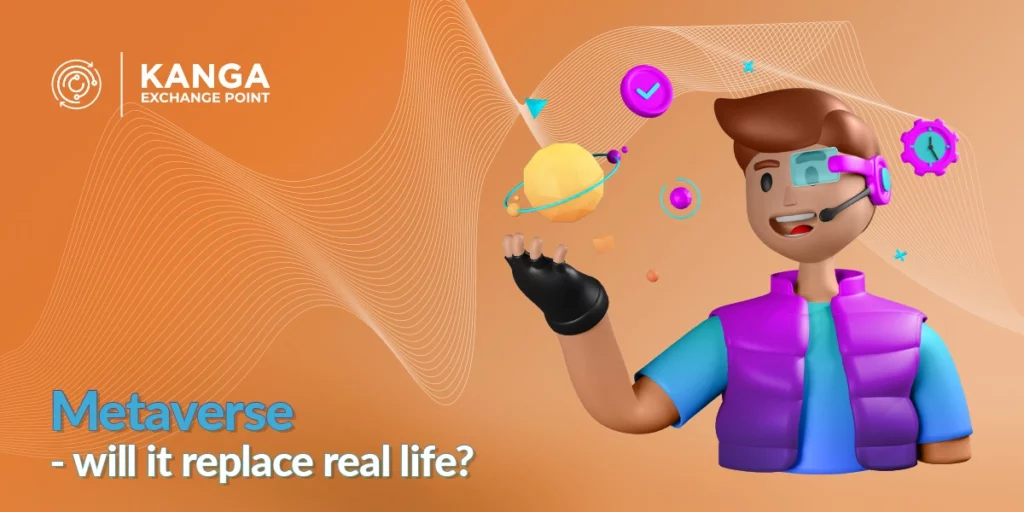Metaverse - will it replace real life?

Virtual reality has fired the imaginations of science fiction writers, filmmakers and the recipients of their works for several decades. Until recently, this concept was only a fantasy sphere. But recently, thanks to entrepreneurs and programmers, it is slowly abandoning it in favor of the tangible world. All thanks to the metaverse technology.
On one side of the coin there is a group of people who treat the metaverse as a temporary curiosity that brings nothing to the status quo. On the other hand, there are voices about another revolution, like the invention of the Internet and blockchain. Regardless of internal beliefs, it must be admitted that the potential of augmented reality (penetrating into such areas as business, entertainment or medicine) is undeniable. Today we will try to answer a frequently repeated question – will metaverse replace real life?
What is metaverse?
The term metaverse was first used by the American science fiction writer Neal Stephenson in his novel Snow Crash (Polish title “Blizzard”) published in 1992. He described the “metaverse” as a powerful computer-generated virtual reality – a metaphor for the real world – in which people interact via avatars. Stephenson used this term to describe the potential next iteration of the Internet. The idea was borrowed from, among others by Ernest Cline, author of Ready Player One, later screened by Steven Spielberg.
The concept is currently being developed by companies such as Facebook and Apple, which are competing fiercely to be the first to release a profitable product. By 2025, the Metaverse is projected to become a billion dollar industry, a platform for innovation, creativity and artistic and technological expression.
How can metaverse change the world?
Sanity
Metaverse is able to solve mental health problems related to PTSD (Post Traumatic Stress Disorder) and anxiety disorders. It can provide those suffering from such disorders a suitable environment in which they can control their surroundings. Added to this is the opportunity to offer people experiences that they would not be able to feel in real life, such as the feeling of flying.
In addition, Metaverse is able to provide a virtual reality therapy environment that helps patients with post-traumatic stress disorder. This type of treatment allows patients to control their own experiences and get rid of any triggers or memories that might be causing them to worry. Additionally, it does not require the use of pharmacology.
Improving education
Assassins’s Creed games gave us a substitute for virtual tourism. Doesn’t visiting Renaissance Italy, the colonial United States, or ancient Egypt through an avatar seem a more interesting prospect than just reading about these places?
Going further: What if, for example, a student of the Academy of Fine Arts had the opportunity to virtually walk around the Louvre using the metavers? This technology will not only change the way we learn, but also the way we teach. Teachers can use it to create immersive activities for students in any subject area, which can lead to greater student involvement in learning.
Work transformation
Creating a metaverse will require a complete change of the way we are currently working. We have already seen the first signs of this in recent years, as more and more companies have adopted open-office plans and employees are encouraged to work from anywhere. Metaverse will only accelerate this trend as it will be easier for people to work remotely and collaborate on projects together.
The use of augmented reality in the workplace will contribute to, inter alia, increase productivity among employees by displaying key information right in front of them during meetings, not to mention a completely different dimension (literally!) of remote check-in.
Metaverse and crypto – how do they interact?
Metaverse is designed to seamlessly blend the physical and virtual worlds, allowing you to acquire or create items in one world and share them in the other. Thus, a virtual presence will require a source of funding – and this is where the topic of cryptocurrencies and NFT (non-exchangeable tokens) comes in.
Some virtual reality platforms allow participation at no cost. However, to trade virtual assets you will need Bitcoin or Ethereum blockchain tokens: MANA, GALA, SAND or APE.
NFTs contain smart contract features that automate and enforce a contract, making it easy to buy, sell, or grant access as needed. Thus, the NFT serves not only to invite others to its own space, but also to gain access to invite-only events, such as metaverse festivals.
So, will metaverse replace real life? Not necessarily. It is fairer to treat this technology as a development of the real world through virtual interfaces. Nevertheless, the future with the use of augmented reality looks interesting and we all have to wait for it!


